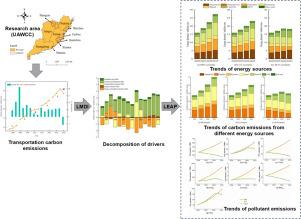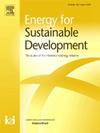中国通往碳峰值交通的道路:能源替代和减排战略
IF 4.9
2区 工程技术
Q2 ENERGY & FUELS
引用次数: 0
摘要
实现交通运输行业碳峰值对于减缓气候变化和促进城市可持续发展至关重要。本研究以中国海峡西岸城市群为研究对象,该城市群是一个交通运输需求大、能源消耗大的重要经济区域。采用对数平均分割指数(LMDI)方法,量化了交通相关碳排放的主要驱动因素,包括能源结构、能源消耗、交通强度、经济发展和人口动态。我们进一步应用长期能源替代规划(LEAP)模型,模拟了2020 - 2035年基线情景、低碳情景和强化低碳情景下的能源消耗和排放。结果表明,如果不进行干预,排放量将继续上升,而在严格的低碳政策下,排放量可能在2030年达到峰值。该分析还纳入了甲烷(CH₄)、一氧化二氮(N₂O)、挥发性有机化合物(VOCs)和二氧化硫(SO₂),对空气质量的共同效益进行了全面评估。该研究为政策制定者在推进清洁能源采用、优化交通结构和制定有针对性的战略以支持中国的碳峰值目标方面提供了有价值的见解。本文章由计算机程序翻译,如有差异,请以英文原文为准。

Pathways towards carbon-peak transportation in China: Energy alternatives and emission mitigation strategies
Achieving carbon peak in the transportation sector is critical for mitigating climate change and promoting sustainable urban development. This study focuses on the Urban Agglomeration on the West Coast of the China Strait (UAWCC), a major economic region with high transportation demand and significant energy consumption. Using the Logarithmic Mean Divisia Index (LMDI) method, we quantify the key drivers of transportation-related carbon emissions, including energy structure, energy consumption, transport intensity, economic development, and population dynamics. We further apply the Long-range Energy Alternatives Planning (LEAP) model to simulate energy consumption and emissions from 2020 to 2035 under baseline, low-carbon, and enhanced low-carbon scenarios. The results indicate that without intervention, emissions will continue to rise, whereas under stringent low-carbon policies, emissions could peak by 2030. The analysis also incorporates methane (CH₄), nitrous oxide (N₂O), volatile organic compounds (VOCs), and sulfur dioxide (SO₂), providing a comprehensive assessment of co-benefits for air quality. The research offers valuable insights for policymakers in advancing clean energy adoption, optimizing transport structures, and formulating targeted strategies to support China's carbon peaking goals.
求助全文
通过发布文献求助,成功后即可免费获取论文全文。
去求助
来源期刊

Energy for Sustainable Development
ENERGY & FUELS-ENERGY & FUELS
CiteScore
8.10
自引率
9.10%
发文量
187
审稿时长
6-12 weeks
期刊介绍:
Published on behalf of the International Energy Initiative, Energy for Sustainable Development is the journal for decision makers, managers, consultants, policy makers, planners and researchers in both government and non-government organizations. It publishes original research and reviews about energy in developing countries, sustainable development, energy resources, technologies, policies and interactions.
 求助内容:
求助内容: 应助结果提醒方式:
应助结果提醒方式:


